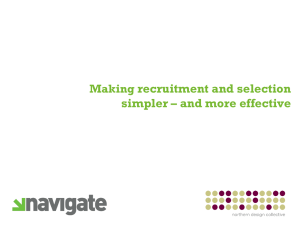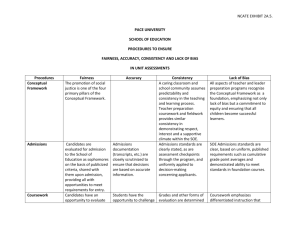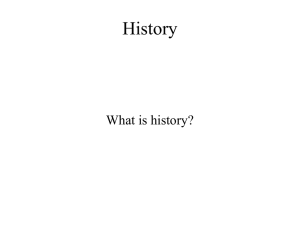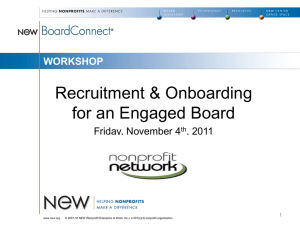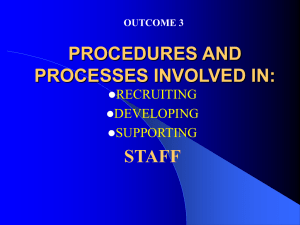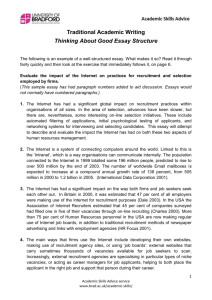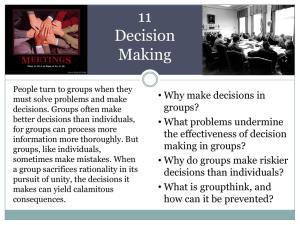Even the most well-intentioned person unwittingly allows
advertisement
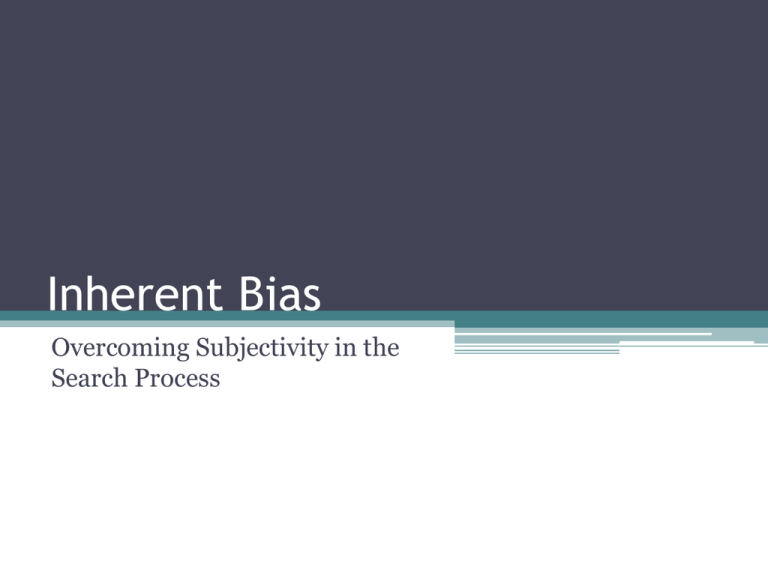
Inherent Bias Overcoming Subjectivity in the Search Process Outline • Definition of Inherent Bias • Job Descriptions/Objective Criteria • Recruiting • Interviews • Steps Forward Inherent Bias • Certain inherent biases are present in all human interactions including hiring decisions: ▫ Assumptions about physical and social characteristics based on race, gender, and ethnicity. ▫ Assumptions related to the level of position or field of study. • “Even the most well-intentioned person unwittingly allows unconscious thoughts and feelings to influence apparently objective decisions.” – Mahzarin R. Banaji Case Studies • Using data from actual auditions for 8 orchestras over the period when screens were introduced, auditions with screens substantially increased the probability that women were advanced (within the orchestra) and that women were hired. These results parallel those found in many studies of the impact of blind review of journal article submissions. • Caffrey, M. (1997, May 12). Blind auditions help women. Princeton Weekly Bulletin. Based on Goldin, C & Rouse, C. (2000). Orchestrating impartiality: The impact of “blind” auditions on female musicians. American Economic Review, 90, 715–741. Case Studies • Subconscious decisions are already being made by an evaluator based on stereotypes about certain names before an interview has taken place. • Bertrand, M., & Mullainathan S. (2004). Are Emily and Greg more employable than Lakisha and Jamal? A field experiment on labor market discrimination. The American Economic Review 94(4), 991–1013; "Employers' Replies to Racial Names." NBER Website. Thursday, August 31, 2006. http://www.nber.org/digest/sep03/w9873.html. Case Studies • A study of postdoctoral fellowships awarded by the Medical Research Council of Sweden found that women candidates needed substantially more publications to achieve the same rating as men, unless they personally knew someone on the panel. • Wenneras, C. & Wold, A. (1997). “Nepotism and sexism in peer-review.” Nature, 387, 341–343. The Search Process • Inherent Bias at Stages of Search Process ▫ Job Description ▫ Bias in Recruiting ▫ Applicant Evaluation/Interviews Job Description • Objective v Subjective Criteria • Possibility of broadening criteria ▫ Publications ▫ Research Specialty Reflexive Exercise • What was the process like on your most recent search committee? ▫ Did you use the same job description historically used by the department? ▫ Were opinions about broadening or changing the job description accepted? ▫ Is there a sense that the ideal candidate should be identical to the incumbent? Job Description • Preferred Qualifications Suggested Language ▫ “Contribute through research, teaching, and/or public engagement to the diversity and excellence of the learning experience.” ▫ “Integrate multicultural experience into instructional methods and research tools.” Suggested Language Cont’d • Preferred Qualifications ▫ “Apply understanding of issues such as diversity and multiculturalism to scholarship.” ▫ “Provide leadership in developing pedagogical techniques designed to meet the needs of diverse learning styles.” Recruitment • Recruitment Efforts Can Include ▫ Paid Advertisements (online and print) ▫ Listservs and Postings ▫ Postings, letters, and contracts with professional associations or conferences ▫ Phone calls and letters to professional contacts ▫ All other networking efforts Recruitment Myths • “The best candidates shouldn’t have to be convinced to apply.” • “People from certain groups/backgrounds would not be interested in UConn.” Reflexive Exercise • Recruitment ▫ Where/how does your department normally recruit? ▫ When was the last time this recruitment strategy was updated? ▫ Is recruiting ongoing even when there is no active search? Suggested Recruitment • The WISE Directories • The Minority and Women Doctoral Directory • Ford Foundation Fellows • IMDiversity.com • Please see ODE’s website for links and additional resources Interviews • Core set of Interview Questions to be asked of all applicants • Ensure all interviewers are aware of what questions are appropriate/inappropriate • Provide opportunities for underrepresented members of the department to meet all candidates not just candidates from those groups Recognizing Bias and Reducing its Impact • Recognizing and accounting for these internal biases can help reduce their impact on the search process and review of candidates. • Openly discussing bias and stereotypes among search committee members. Consciously strive to minimize these influences on the evaluation process. Steps Forward • Recruit to increase women and minorities in the applicant pool. • Apply criteria consistently to all applicants. All candidates should start with a blank slate. • Spend substantial time evaluating each applicant. Steps Forward Cont’d • Evaluate the complete application. • Provide qualification related defenses and justifications for eliminating (or advancing) a candidate. Final Reflexive Exercise • What have you learned? ▫ Do changes need to be made to your department’s hiring culture? ▫ What concerns will you bring up the next time you are on a search committee? ▫ What are your personal/professional steps forward?

